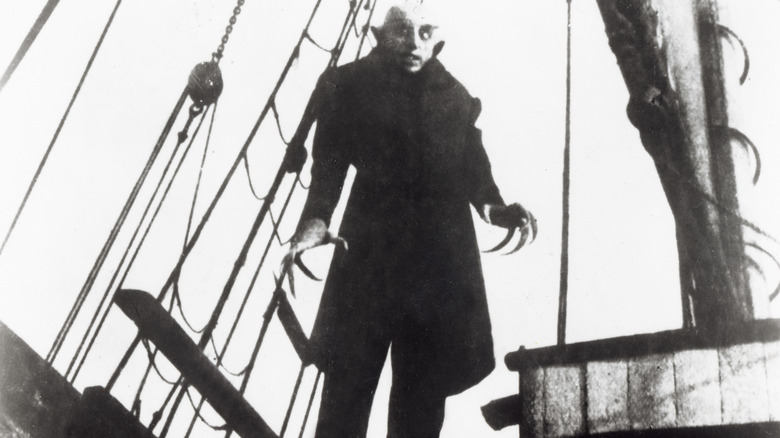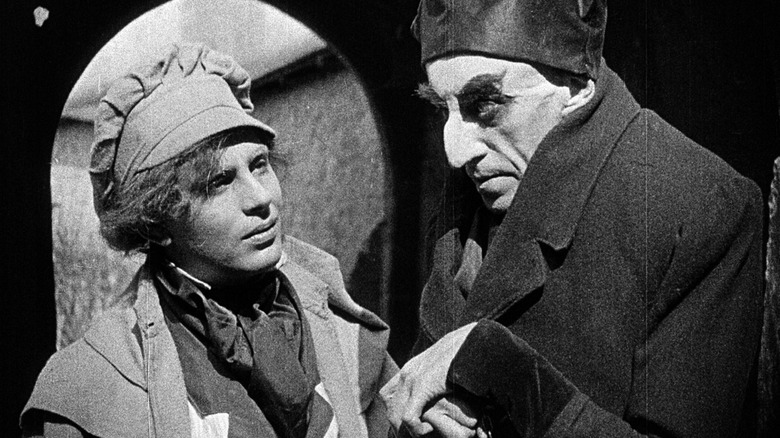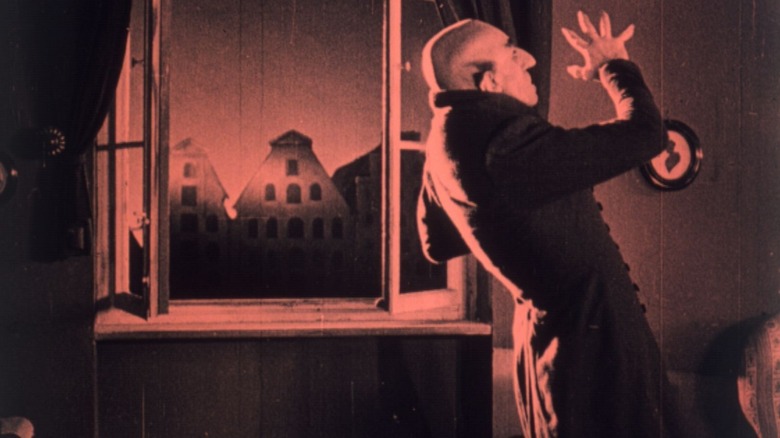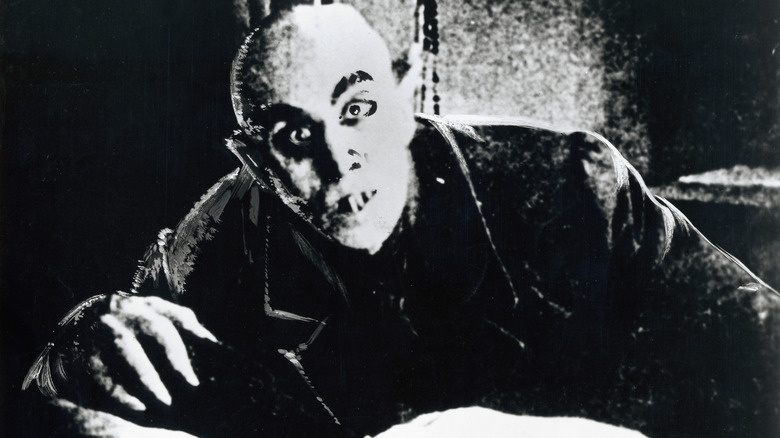How Nosferatu Rewrote The Rules Of Vampires
It's generally accepted that a vampire can only die under several specific circumstances: direct sunlight, a wooden stake through the heart, a bath in holy water, etc. The means of bloodsucker dispatch do sometimes require the procedure to be more elaborate, such as in "Tales from the Crypt Presents: Bordello of Blood," where the vampire queen Lilith (Angie Everhart) needed her heart removed from her body and then sliced into four equal pieces. But the movies have taught us a few near-universal rules for making the undead dead. No fifth-grader with a passing knowledge of film history will be unprepared for vampire battle.
While stories of demon-like creatures that drink blood and/or are immortal can be traced back to the most ancient civilizations, the modern folkloric version of the vampire — the night-dwelling, blood-drinking, unkillable, fanged creature — didn't begin until the early-to-mid 18th century in southeastern Europe, and were connected with paranoia about demons infiltrating small towns for malevolent purposes. Like in the Salem Witch Trials (1692 – '93), some communities in New England even undertook arcane rituals to rid themselves of what they believed to be vampiric interlopers in their communities.
But when it comes to modern vampires, the true moment of codification came with the release of F.W. Murnau's horror classic "Nosferatu" in 1922. It is from this film that several pieces of popularly-repeated vampire details originated.
F.W. Murnau vs. The Bram Stoker Estate
Prana Film, the German studio that made "Nosferatu," was founded in 1921 by Enrico Dieckmann and an artist named Albin Grau, who had a taste for the occult. The idea of Prana Film was to house a long series of occult and supernatural feature films, but the studio folded quickly after making just one. According to the 1993 biography by Christiane Mückenberger, Grau claimed that he was inspired to make a vampire film after hearing a "true" vampire story from a Serbian farmer while Grau was serving as a soldier during World War I. Grau and Dieckmann, who infamously had not secured the film rights to the popular 1897 novel "Dracula" by Bram Stoker, put their Dracula movie "Nosferatu" into production in 1921, with F.W. Murnau directing, and shooting locations secured in Slovakia.
Because it was clearly an adaptation of Stoker's works, and because Prana didn't have legal permission to make the film, Stoker's widow successfully sued the company and all copies of "Nosferatu" were ordered destroyed. Luckily for film historians, copies of the film did survive, and "Nosferatu" is available to this day.
"Nosferatu" screenwriter Henrik Galeen apparently didn't actually read Stoker's novel, so while the story remains the same, many of the details differ. The names have all changed, for one, with Count Dracula becoming Count Orlok, and so on. In the novel, Dracula is a short old man with a mustache who becomes temporarily younger after drinking the blood of his victims. In "Nosferatu," Orlok (played by Max Schreck) is a lanky, rat-like creature whose terrifying countenance embodies pestilence and death. Indeed, the design of Count Orlok has led to claims of antisemitism on the part of the filmmakers; Orlok's nose and claws were popular in negative Jewish caricatures at the time, and the character's "invasion of Germany" narrative mirrors similar fears expressed in antisemitic pamphlets of the early 1920s.
The rules of vampires were also laid down: In "Nosferatu," the vampire must travel with coffins full of earth, presumably, as one intertitle explains, the soil that a vampire was initially buried under. A more notable deviation from Stoker was the conceit that a vampire can only operate at night — Stoker's Dracula was free to come and go at all hours. It was actually "Nosferatu" that popularized the notion that vampires have an aversion to sunlight.
F.W. Murnau's sunrise
The finale of "Nosferatu" involves Orlok sneaking into the bedchamber of Ellen Hutter (Greta Schröder) at her invitation. Ellen had read from a book that a vampire can be defeated if a pure-hearted woman can distract it with her innocence and beauty. Orlok intended to drink Ellen's blood and get out, but was so moved by her good looks, that he stayed by her bedside all night. At sunrise, when the day's first light came in through the open window, the vampire was disintegrated.
The concept in "Nosferatu" was of a moral bent. It wasn't necessarily ultraviolet solar radiation that seared through the vampire's flesh, but innocence and purity tearing through diseased evil. A vampire is traditionally an unholy monster, one that shies away from crosses and other holy symbols. This stems from the above-mentioned lore that a vampire is a kind of a demon. In "Nosferatu," the vampire is more or less the embodiment of pestilence, the horseman of the apocalypse. Orlok spreads disease wherever he goes, and is made to look like plague vermin. The only way to combat such a creature is with purity so strong that it can erase death. Orlok, then, was not killed by sunlight, but by the combined holy power of an innocent woman and the Easter-like Christian-resurrection life symbol of the rising sun. Is the "innocent woman" imagery condescending and sexist? Yes. Is the ending to the film kind of corny? Yes. Does it work as a corking piece of horror cinema? You bet. The last look on Count Orlok's face when he realizes he has been duped is an "oh s***" moment for the ages.
Whatever the symbolism, the literal image of a vampire being evaporated by sunlight lodged itself into the popular consciousness, and after 1922, it became widely accepted that sunlight kills vampires.
Holy water Super Soakers and sun lamps
This notion of a vampire's allergy to sunlight — like a lot of vampire lore introduced in the movies — became very literal very quickly. An unholy, violent, life-taking creature will, moving forward, not be undone by the concepts of holiness, calm, and innocence, but by the actual mechanical qualities of holy water in squirt guns, crosses made by any two planks of wood, and ultraviolet sunlamps. Fighting vampires soon became a military matter, requiring only the correct weapons and the bravery to wield them. Actual religious belief, innocence, and piety were shed as concerns so long as you had a Catholic priest and a Super Soaker.
Nine years later, director Tod Browning would make his own version of "Dracula," this time with rights from the Stoker estate secured. It solidified another version of what Dracula (and many other vampires) would look and sound like for generations: the elegant, yet masculine, sexy foreign aristocrat decked out in a tuxedo and cape. Moving forward, vampires were either monstrous, disease-spreading rodents a la "Nosferatu," or handsome Eastern European men like Bela Lugosi. Throughout them all, vampires would be undone by sunlight, requiring their vitamin D supply from the blood they drink.
The most notable vampire unaffected by sunlight is Edward Cullen from Stephenie Meyer's "Twilight" book series. In the lore of the "Twilight" novels, vampires stay out of the sun, but only because direct sunlight causes their skin to sparkle like diamonds, making them too beautiful to live. Points to Meyer for effectively reworking a trope begun in 1922.



